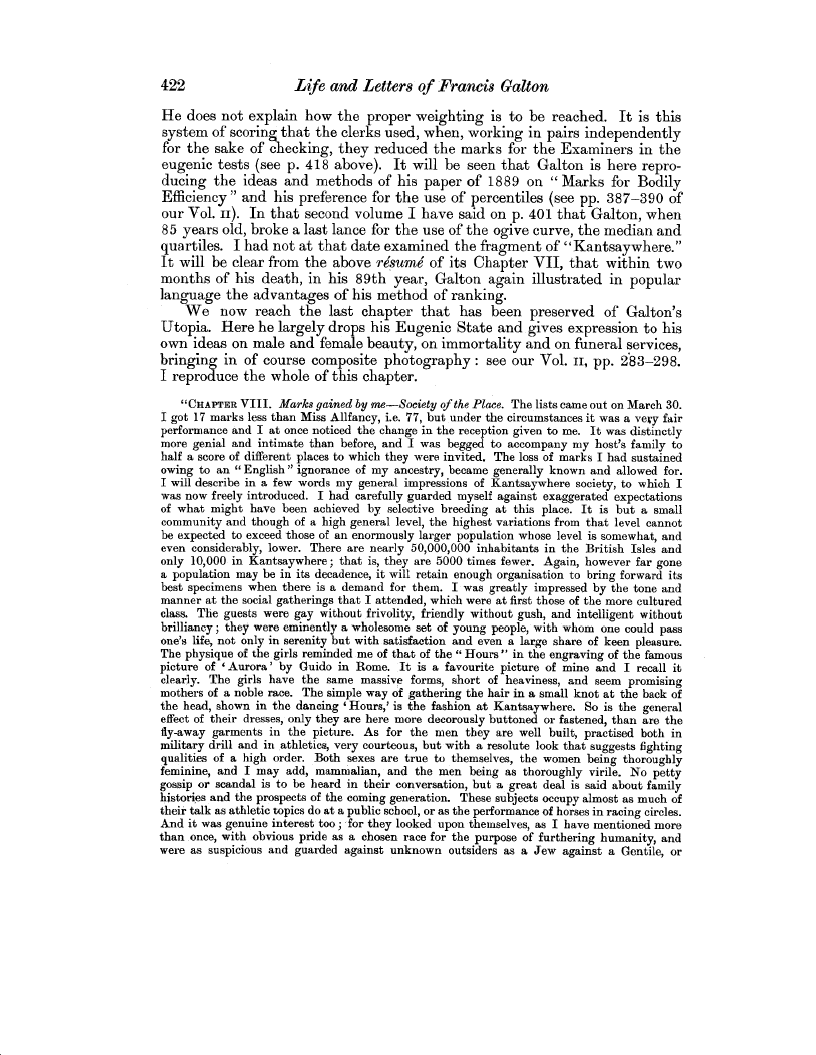422 Life and Letters of Francis Galton
He does not explain how the proper weighting is to be reached. It is this system of scoringg that the clerks used, when, working in pairs independently for the sake of checking, they reduced the marks for the Examiners in the eugenic tests (see p. 418 above). It will be seen that Galton is here reproducing the ideas and methods of his paper of 1889 on " Marks for Bodily Efficiency" and his preference for the use of percentiles (see pp. 387-390 of our Vol. ii). In that second volume I have said on p. 401 that Galton, when 85 years old, broke a last lance for the use of the ogive curve, the median and quartiles. I had not at that date examined the fragment of "Kantsaywhere." It will be clear from the above resume of its Chapter VII, that within two months of his death, in his 89th year, Galton again illustrated in popular language the advantages of his method of ranking.
We now reach the last chapter that has been preserved of Galton's Utopia. Here he largely drops his Eugenic State and gives expression to his own ideas on male and female beauty, on immortality and on funeral services, bringing in of course composite photography : see our Vol. II, pp. 2.83-298. I reproduce the whole of this chapter.
"CHAPTER VIII. Marks gained by me-Society of the Place. The lists came out on March 30. I got 17 marks less than Miss Allfancy, i.e. 77, but under the circumstances it was a vevy fair performance and I at once noticed the change in the reception given to me. It was distinctly more genial and intimate than before, and I was begged to accompany my host's family to half a score of different places to which they were invited. The loss of marks I had sustained owing to an " English " ignorance of my ancestry, became generally known and allowed for. I will describe in a few words my general impressions of Kantsaywhere society, to which I was now freely introduced. I had carefully guarded myself against exaggerated expectations of what might have been achieved by selective breeding at this place. It is but a small community and though of a high general level, the highest variations from that level cannot be expected to exceed those of an enormously larger population whose level is somewhat, and even considerably, lower. There are nearly 50,000,000 inhabitants in the British Isles and only 10,000 in Kantsaywhere; that is, they are 5000 times fewer. Again, however far gone a population may be in its decadence, it will retain enough organisation to bring forward its best specimens when there is a demand for them. I was greatly impressed by the tone and manner at the social gatherings that I attended, which were at first those of the more cultured class. The guests were gay without frivolity, friendly without gush, and intelligent without brilliancy ; they were eminently a wholesome set of young people, with whom one could pass one's life, not only in serenity but with satisfaction and even a large share of keen pleasure. The physique of the girls reminded me of that of the " Hours " in the engraving of the famous picture of I Aurora' by Guido in Rome. It is a favourite picture of mine and I recall it clearly. The girls have the same massive forms, short of heaviness, and seem promising mothers of a noble race. The simple way of gathering the hair in a small knot at the back of the head, shown in the dancing ' Hours,' is the fashion at Kantsaywhere. So is the general effect of their dresses, only they are here more decorously buttoned or fastened, than are the fly-away garments in the picture. As for the men they are well built, practised both in military drill and in athletics, very courteous, but with a resolute look that suggests fighting qualities of a high order. Both sexes are true to themselves, the women being thoroughly feminine, and I may add, mammalian, and the men being as thoroughly virile. No petty gossip or scandal is to be heard in their conversation, but a great deal is said about family histories and the prospects of the coming generation. These subjects occupy almost as much of their talk as athletic topics do at a public school, or as the performance of horses in racing circles. And it was genuine interest too; for they looked upon themselves, as I have mentioned more than once, with obvious pride as a chosen race for the purpose of furthering humanity, and were as suspicious and guarded against unknown outsiders as a Jew against a Gentile, or
